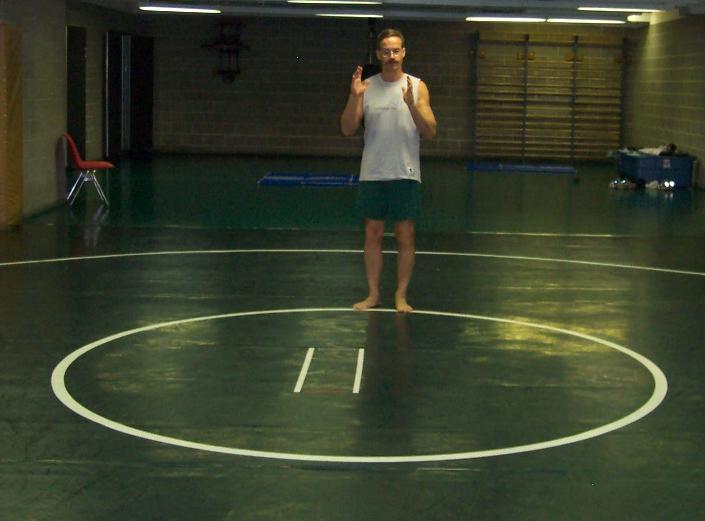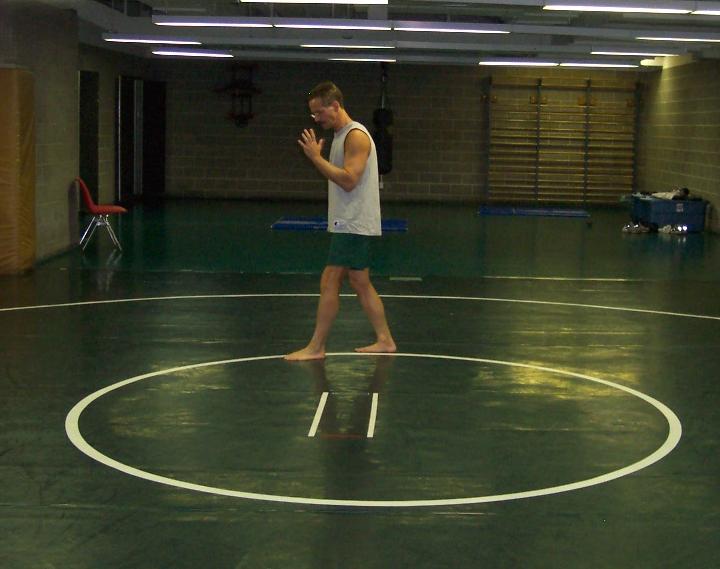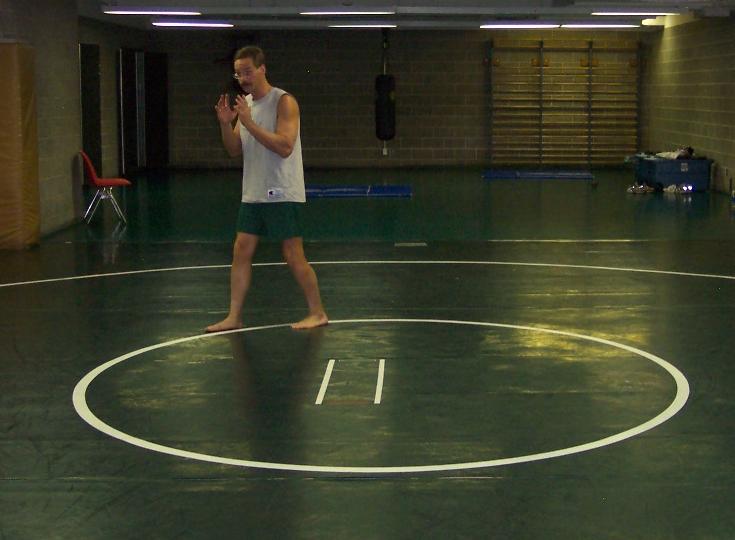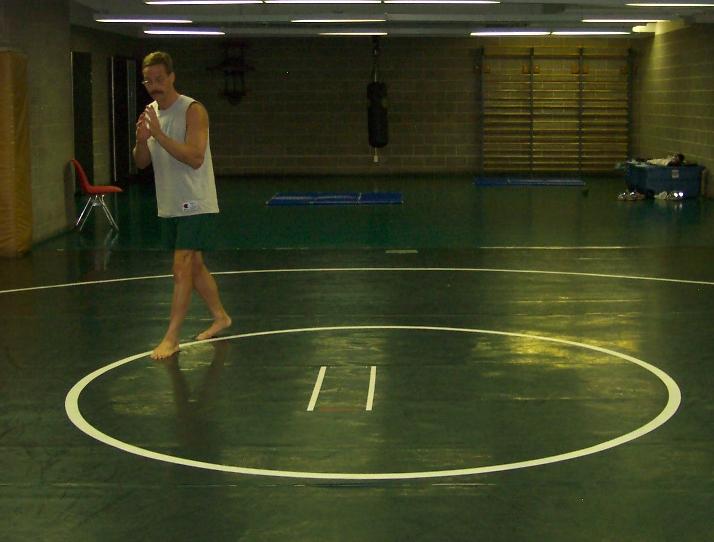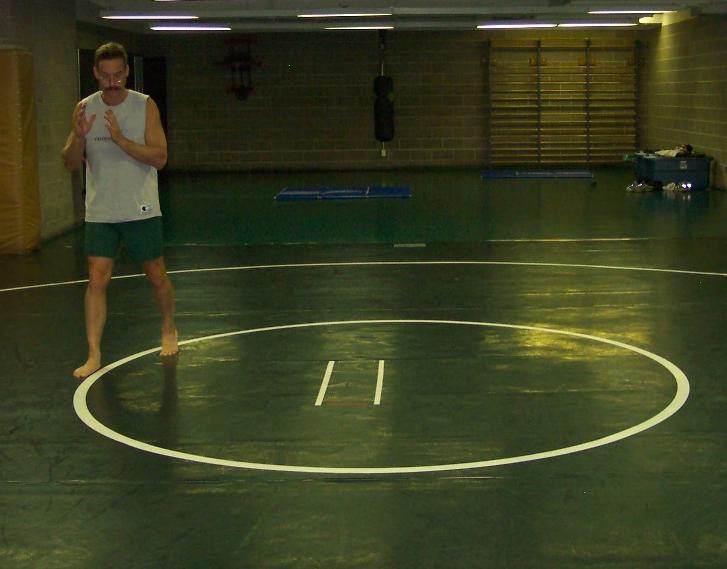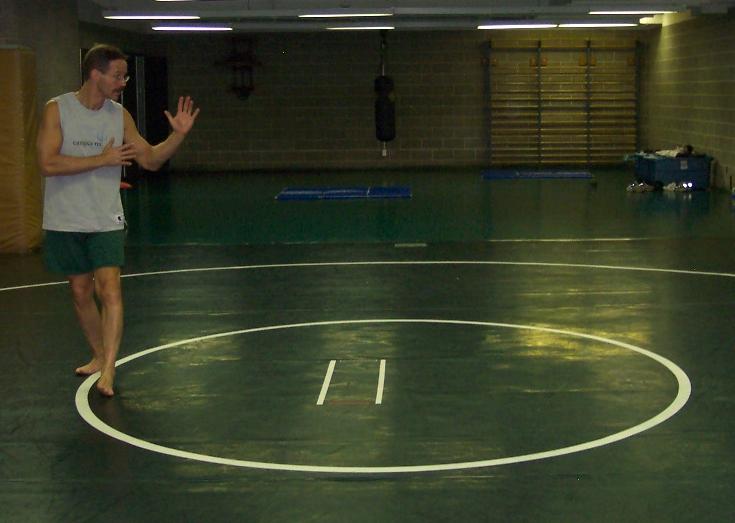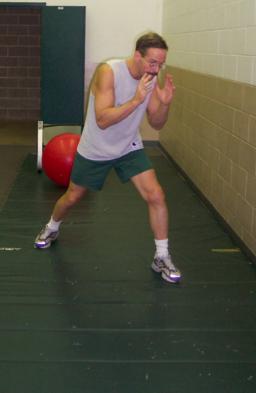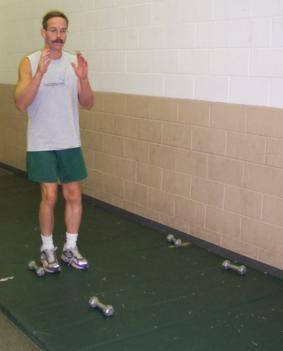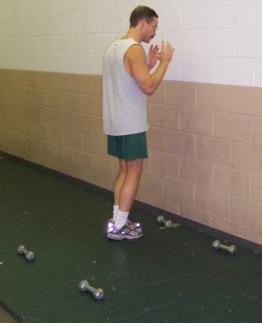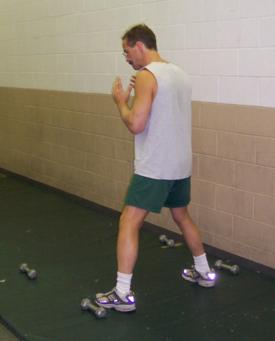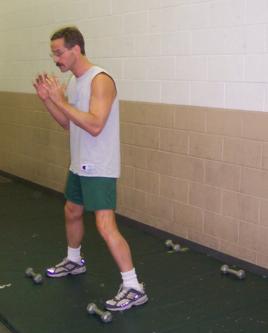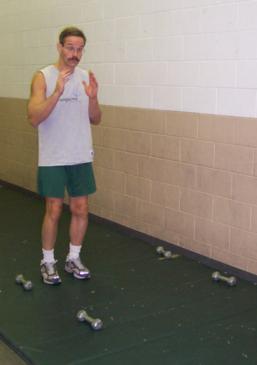Basic Footwork drills
These are just the basic drills that you can do
for footwork. By footwork I mean
how to use your feet in motion so that you may stay in balance, root as
needed (can't be fast and root) and have as many of your weapons
available as possible. When people
start moving and trying to do techniques at a faster pace, it is easy
to be so uncoordinated
as to be completely ineffective. Yes, footwork can render the best
technique unusable.
The stance work and partner exercises will go a long way
to helping, but there need to be solo and partner drills for moving.
That is what this section
contains. Footwork is not rocket science. It is actually really simple
but takes a lot of
practice to get it fluid and smooth. It must be to the point that your
feet do what they need
to without much conscious effort. If you have to really concentrate on
your feet to do these
they won't do you much good. Make it automatic. If you are looking for
the advanced footwork drills, start here.
In a nutshell here is how you can move
- One foot one the ground at a time, feet alternately pass one
another - walking
- ditto, axis change of hips - pivot
- One foot one the ground at a time, feet do not pass. Lead leg
moves first
- Ditto, read leg moves first
- Both feet on the ground - can only change angle of hips - twisting
- Both feet off ground - jumping (N.B. can land with both feet or
one foot)
There are two basic modes of travel. Walking (ayumi
ashi) where one foot passes the
other. Walking is, you know, walking:
What you don't walk in circles sometimes? Ok, this
is a specialized drill called walking the
circle.
But it really is just walking. In this I keep my hands on my centerline
and in the last frame twist to
face the center – which is where my opponent actually would be.
The other method of locomotion is shuffling, where the feet do not
pass each other.
 |
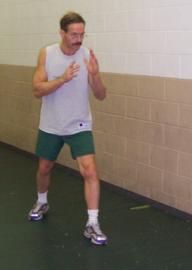 |
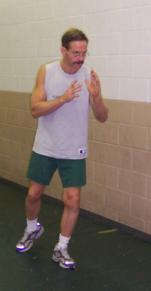 |
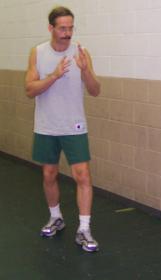 |
| Tsugi ashi or step + drag |
Step with the leg into
the direction of travel |
Shift weight slightly and
drag the other foot |
Ready for another. |
Click here for a movie of tsugi
ashi.
When shuffling, you have two
options, either step then drag the leg up (this is what is usually
meant by the phrase tsugi ashi or "thrusting step" and we will
call this
step+drag. The other option drag the trailing foot then step
(cleverly called drag+step), called
okuri ashi or "trailing step". The difference is which foot you
care to load.
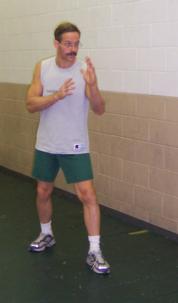 |
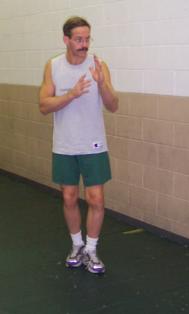 |
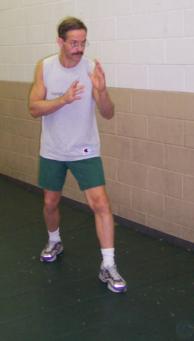 |
| Okuri ashi or drag + step |
Drag rear leg into the
direction of travel |
Step with the lead leg |
Click here for a movie of okuri
ashi.
Remember that you cannot, for instance, strike without root. so
step+drag means that the side of leading
foot can fire a punch or the opposite leg can kick, sweep etc. With
drag+step, the roles are reversed
and the trailing foot is now loaded for action. Also, if you must
retreat, i.e. move
backwards, shuffling is the better way to do it rather than walking.
Sometimes this holds for advancing
too. Of course, you should not retreat unless you have a plan on what
to do, since you are far less
efficient at retreating than he is at advancing. The default movement
should be evasion to 1 o'clock or 11 o'clock.
As a comment, the two standard sweeps of de ashi barai and okuri
ashi barai are
intended to counter someone who is shuffling in resp. tsugi ashi
or okuri ashi. Other sweeps
are intended for intercepting someone who is walking, pivoting, etc.
Sweeps are to be used in motion, never statically. An easy way to do
this is to practice your footwork drills while your partner sweeps
you. You get to move naturally as does he.
Another fundamental movement is pivoting,
which is walking with a change in the axis of the hips. This is often
subsumed under the classical
heading of kaiten (literally 'circle' since you move along an
arc), although this is not quite correct. There are two version of it
and they are very different. The
first, called twisting has the feet not moving. You rise onto
the balls of your feet and twist your
hips so your hara (center of gravity, about where your belt
knot is) points into
another direction. Key point is that
your feet stay on the ground. You then regain your root. The
other version, called
pivoting actually moves one leg
while keeping the other as the center of rotation. in which one foot,
the pivot foot, remains
in location and the other foot, the sweeping foot, moves to a
new location. The pivot foot
is the center of rotation and the heel of that foot comes off slightly
the floor, so that the pivot is on the
ball of the foot. This prevents the knee from suffering torsion, since
the pivot actually occurs at the hip -- if you stay flat-footed your
knee will undergo torque. You
may move the sweeping foot
to the front or rear, called a front or rear pivot, resp. Key for pivot is that is a type of walking
with a change in hip angle, i.e., you are one-legged during a pivot and
a biped during a twist!!! Pivots are excellent for quick
movements offline (again speed cancels root), but don't expect to get
much power. Stylistically we usually prefer to replace a pivot by a
step + twist or twist+step if we need power.
Now we won't be confusing just like everyone
else. Most folks lump twists and pivots together.
People don't make as big a distinction as they should, but we will try
to. If you cannot separate these, you will find that many techniques
simply lose all power mysteriously in the middle of their execution
because you pivot where you should twist.
Pivots may occur up to and including a full 360
degrees. twists can go also go to a maximum of 360 degrees if you start
in a kosa dachi and end in
one.
The 180 degree twist is especially useful. You pivot or twist when you
need to change orientation or look around. You should practice scanning
(looking
around, without a body twist) at the very least with every pivot, and
you should actually look,
don't just wag your head. This is again aimed at assessing multiple
attackers and the area. In such
cases remember that you are looking for the biggest threat and that
might not be the person closest to you.
All footwork drills should start by having your
hands covering your center line and doing the
appropriate palm changes so that the side that leads has that hand
forward. It is crucial that
after you get comfortable moving, you then run through your footwork
drills using various hand
techniques (escapes, te kagami, etc., etc.) so that you get
used to having your upper and
lower body independent. Your feet eventually should being doing
whatever they have to all
by themselves. You want to smarten your periphery.
In application, you will never use more than a
couple or three steps of one of these drills, since
setting up a pattern gives your attacker all he needs to know to find
you. The objective of drills
is, of course, to give you the ability to do these smoothly and
therefore switch seamlessly between them.
Once you have these
down, practice combinations, alternating footwork drills every few
steps.
Always practice scanning the area in your
drills. That is to say, look around and try to
be aware. You have to incorporate this so it is completely automatic.
The footwork is made
to keep you in motion so that multiple attackers can't hem you in. It
is easy, either from solo practice
or lots of practice with a single partner, to forget this fact. The old
boxer's saying that "It's
the one you never see that puts you away" is accurate. All the evasive
footwork in the world
won't help you if you don't observe your environment.
Practice altering the step size and rhythm.
These should be practiced as lunges too and mix it
up. You can never have enough controlled chaos in training. You should
also consider practicing these
plyometrically, that is to say, if you lunge, then at the instance your
leg is loaded with your
weight, explosively reverse direction. This will build enormous speed
and power.
Another great drill by yourself is to
do ukemi as part of this. That is to say, select a footwork
drill and at some point, have
a roll, side fall, etc. whatever you like. This gets you used to moving
and falling while in motion.
Believe me, every time I've had to roll, it was because I was out of
control (bike accident, tripping and
such). Being able to roll-out while in motion should be taught in
public schools as a matter of safety.
This is a rolling drill, rather than a footwork drill, but this is a
proper place to include it.
You can also have partners hold up sticks (jo,
bokken, baseball bat or whatever)
at shoulder height and practice your footwork moving
around them. Alternately, your partner can spruce this up by trying to
tag you, either with hands, feet or
other household items as you move to retain position. Be sure the
partner does them high, medium and low.
This is good bobbing and weaving practice. Start out just with lazy
swats
since there will be a lot going on. Eventually, these will metamorphize
into strikes, grabs and kicks.
Other partner drills with all of these can
easily be done. One person lead and the other mirror the
movements, maintaining constant distance. This can be done not merely
with the partners
facing each other, but maintaining an angle (so the follower, for
instance, wants to
stay on a given 45 degree line to the leader at all times). Boxer's use
what they call the "triangle theory" of movement: You and your opponent
always form vertices of an equilateral triangle. If the opponent moves,
then you are to move to the appropriate new vertex. This makes a nice
drill too, with the leader moving as desired and
the follower maintaining the triangle. The leader or follower can also
add tags using hands and feet to make
the other bob and weave while in motion.
Start slowly, since the leader has and advantage, but eventually
this can be quite fast too.
Playing tag is an excellent addition. That is
to say, as you shadow or evade he should try to
grab or swat you initially and eventually ramp it up to strikes.
The bad guy should try to telegraph so that you will get practice
at reading the body. People who do not have years of training telegraph
badly and not being able to pick up on it
while in motion might mean you walk into a full power strike. That
would probably end the altercation right
there and not in your favor, I should stress...
8 direction drill Run around into the
eight directions, walking a couple of steps, then
reverse (walk backwards) to the starting point. You should start out
twisting into the direction
then moving. You can also vary this by always facing forward, so that
the rear directions have
you initially walking backwards.
Zig zag.
You will be moving in a zig-zag pattern while
you partner moves in a straight line.
Have your partner hold out both hands straight at shoulder height. As
he walks backwards, you should
move on either side of him with a walking pattern just like walking in
a front stance. Also practice
being close enough that you must bob under his arms. Another version of
this has your partner just holding
one hand out and shuffling. Practice forward and back. Do not lust bend over! Maintain good
posture since being off-balance will leave you very vulnerable to
counter attack.
Walking the circle. Click here for a movie.
(This movie shows walking the circle with palm changes and a few S
turns through the middle of
the circle.)
This actually comes from a groovy Chinese martial art called ba gua
(also written
p'a k'ua by some). Ba gua is famous for its fluid and
evasive footwork,
and this is their core drill. The system makes a good complement to jujutsu
and one of my first teachers was very good at it. You should walk, that
is to say, stride
as you normally do down the street (heel-toe walking). To move at an
angle, point your toes in the
direction you want to go. The eight directions move from the center of
the circle, while this drill gets you to move on the perimeter. If you
do both types of drills, you should have pretty much
all possibilities covered.
Walking the circle is a deceptively simple drill that has an
enormous payback, so
you should practice this one a lot. I do it most days of the week for
at least a bit. Mark off
a circle who radius is your height. Walk along the perimeter for
several minutes, being sure
that you are in balance. You may switch direction by simply pivoting
180 degrees. Practice these
pivots. Moving in a straight line with root is never a problem with a
little practice, but as soon as
some curvature enters the picture, people lose root. A circle has
constant curvature and therefore
this simple drill lets you practice rooting along a curved path. You
can even do pushing exercises
with a partner as well if you get so inspired.
A very good and simple variation of this is to walk half the circle
then cut an S-shaped path through the middle (ok, ba gua
started out as a bunch of Taoist monks walking in a circle for
meditation and this really is tracing a yin-yang symbol on the ground).
The movie
above shows this. If you
started walking, say, clockwise initially, this move will have you
walking counter-clockwise from
your starting point.
When you get back to the point on the circle opposite from the start,
repeat cutting through the middle
of the circle and you will be at your point of origin with the original
orientation. This does several things.
It
- lets you practice tighter turns in the middle,
- lets you do techniques on both sides without having to change
directions.
All in all, a superb drill. One other benefit of walking the circle (or
doing any of the other drills
on the circle) is that you have a definite intent of going someplace.
Practicing getting from point A to B with
your footwork is a good goal and closely follows practice.
Philosophical/pedagogical
digression: Jujutsu has a pretty well worked out system of
teaching footwork for moving from the center of the circle to the edge,
which mimics most evasive movements against linear attacks. Most
advanced counter techniques though move along a circular path -- i.e., along the circumference of
the circle. The pedagogy there is less clear cut, but the net effect is
strikingly similar ba' gua. Ba' gua's circle drill is a very
convenient way to practice this and gives an excellent paradigm for
getting the requisite independence of hands ond feet. However, I hasten
to point out that this is a single footwork drill that has been
adapated for our use and has virtually nothing else to do with ba 'gua, which is a vast and
difficult art.
8 direction drill Shuffle into 8
directions, then back to the starting point. Be sure you leave nothing
behind at the starting point of the shuffle (the bad guy is trying to
get to exactly where
you were, and anything there is a target). Another easy variation is to
move and fire a strike (low kick, punch,
palm heel, whatever) exactly where you were. Practice both the
step+drag and drag+step and note what
techniques you have available depending on which leg is loaded. Another
variation is to shuffle
a couple of steps, then pivot and run through various pivots, twists
and
shuffles with various permutations of the eight directions.
On the circle You can also practice
shuffling along the perimeter of a circle, just like
walking the circle. Be sure to face into the circle and to the outside
rather than just facing in the direction of travel. This gets you to
practice shuffling laterally along a curve, for those cases where you
can't
afford to take your eyes off of something.
There are a few drills for pivoting and
twisting. These are not rocket science. A lot of people underestimate
their utility though. The most common way to fall down in a fight is to
duck something (you will do this reflexively), causing a change in the
angle of the hips. Normally the body is not used to this and lacking a
sense for it, will try to locomote in a compromised position, which can
cause you to lose balance and fall. Having
the basic body sense to simply complete the pivot and restore balance
will do much to prevent losing balance, but it must be practiced diligently
for a while.
8 direction drill. Pivot into each
direction, You do this in any of the
following ways (practice them all).
For turning practice, step into a
direction and turning 180 degrees to face your starting point, Reverse
the motion.
The line drill.This actually works
both twists and pivots. This is lateral, so
that if you were using it, your opponent would be at 3 or 9 o'clock.
Face your opponent
by looking over your shoulder, say starting at 9 o'clock. Pivot three
times 180 degrees to look at
3 o'clock and back again. The three pivots now have you facing to 3
o'clock. Shuffle away a couple
of steps on the line
and now perform 3 inside pivots, shuffle away a couple of steps and
perform three outside pivots. You are
now back at the starting point.
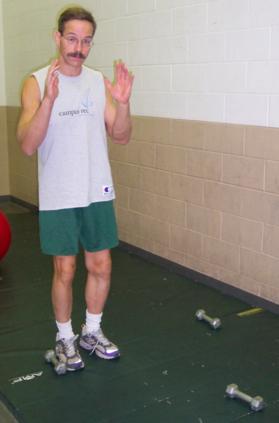 |
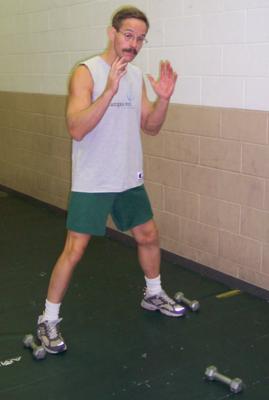 |
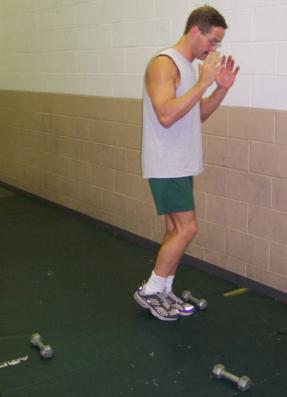 |
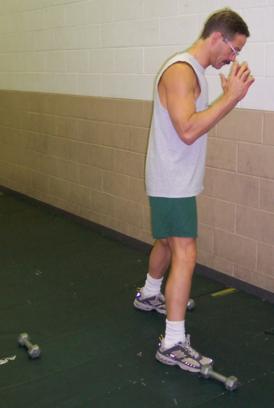 |
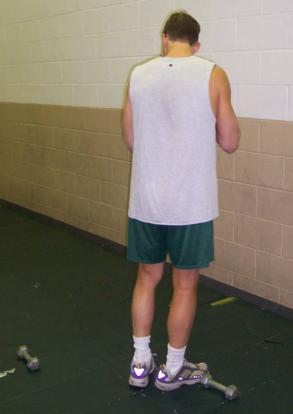 |
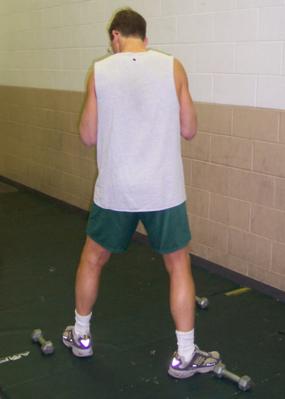 |
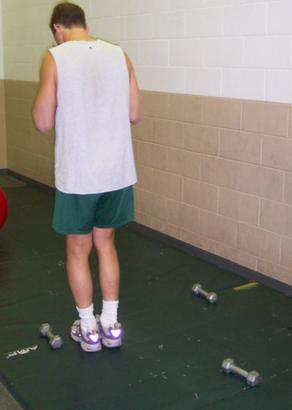 |
| The first pass through the triangle drill. |
Triangle drill. Click here for a movie.
Mark out an equialteral triangle. Step at the vertices. In the
pictures,
I've put weights on the floor to show where the triangle vertices are.
Be sure to bring your feet together on
the movement. After each pivot, do a quick turn to scan the area.
You can also just do this as a speed drill omitting the turns to see
how fast you can pivot. Remember that
while this is loads of fun, you are leaving out the important component
of scanning to just
optimize your speed.
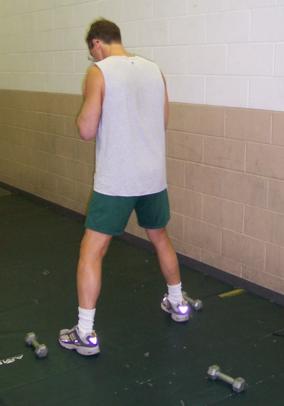 |
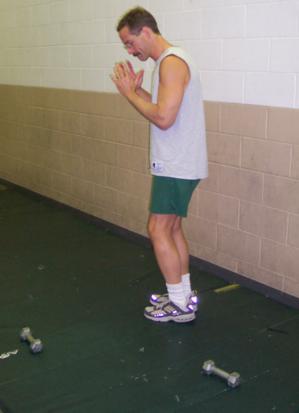 |
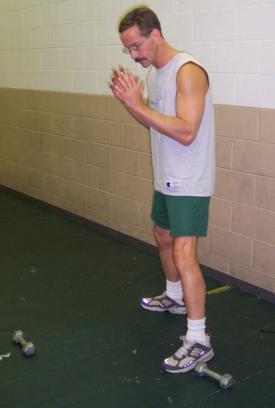 |
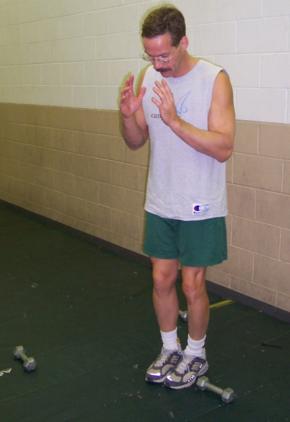 |
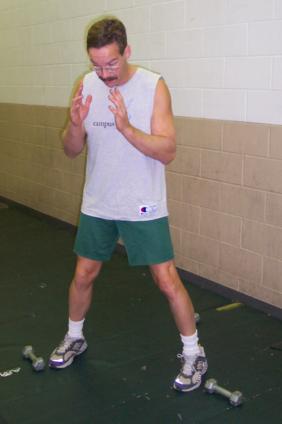 |
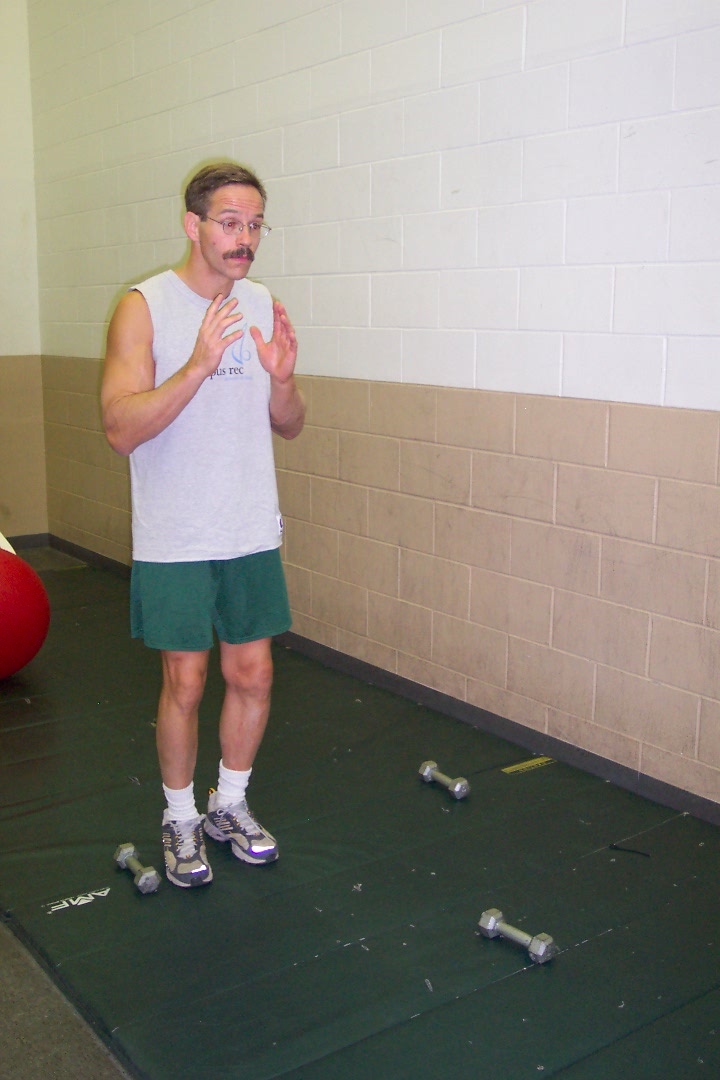 |
| The second pass through the triangle drill. |
Once around the
triangle will not get you back where you started, meaning that your
starting position is to the inside of
the triangle. After a circuit, you will facing the outside of the
triangle, but a futher circuit will
get you back. Repeat on the other side. This gets you to practice 60
degree pivots.
Box drill
Click here for a movie.
Very similar to the triangle drill, but have a square. In the picture I
have the vertices
marked with weights. Unlike the triangle drill you always return to the
same starting position
with each circuit. Do both sides. This gets you to practice 90 degree
pivots.
You could get carried away and do other polygons, but that's not worth
the effort or the mental gymnastics.
With both the triangle and box drills, you don't need to do them for
speed, although that
is fun to practice. The big thing is practicing looking around you.
Can't emphasize that enough.
Pivots and twists on the circle. This is another fabulous
drill. Twists are quite natural on the
circle and pivots are excellent too. For the twists, do them without
pausing, so you can literally
make a twist as soon as the stepping foot touches the floor. This
little
trick will greatly improve the fluidity of your twists.
In our great tradition of ripping off excellent footwork drill from
others we give you the dot drill.
This is a really great footwork drill from the
1940's by Adolph Rupp for his basketball players. Visualize 5 dots,
just like on a die:
D E
C
A B
A and B are shoulder width apart, as are D and E. C
is directly in the middle and the distance from
A to D is two shoulder widths (can be a bit more if you like a
challenge).
Now, There are several hopping patterns. Choose a few and do each
one 5
times. Time yourself and see if you can't
best your own time. These are:
- (Hourglass) Left foot on A, right on B. Hop so both feet
are on C, then hop with legs apart to D and E. Reverse the motion,
hopping backwards.
- (Hourglass twist) Same as the first one, but when you get to
each end, do a 180
degree jump in the air, feet apart. This just keeps you always facing
in the
direction of travel.
- (Figure 8) Feet together do one side then the other: A - C -
D - E - C - B
- (Triangle) Feet apart on A+B hop together on C then back. Also
together on C then apart on D - E.
- (L's) Feet together A - B - E and reverse. Do the other side: B -
A - D.
- (M's) Feet together A - D - C - E - B. Reverse.
- (N's) Feet together A - D - C - B - E
- (O's) Feet together A - D - E - B and reverse it.
This is fun and actually counts as cardio
training too... You can do many of these one -footed too. Note: for
those of us with ankle and/or knee trouble, doing feet together is a
very knee safe way to train jumping.
